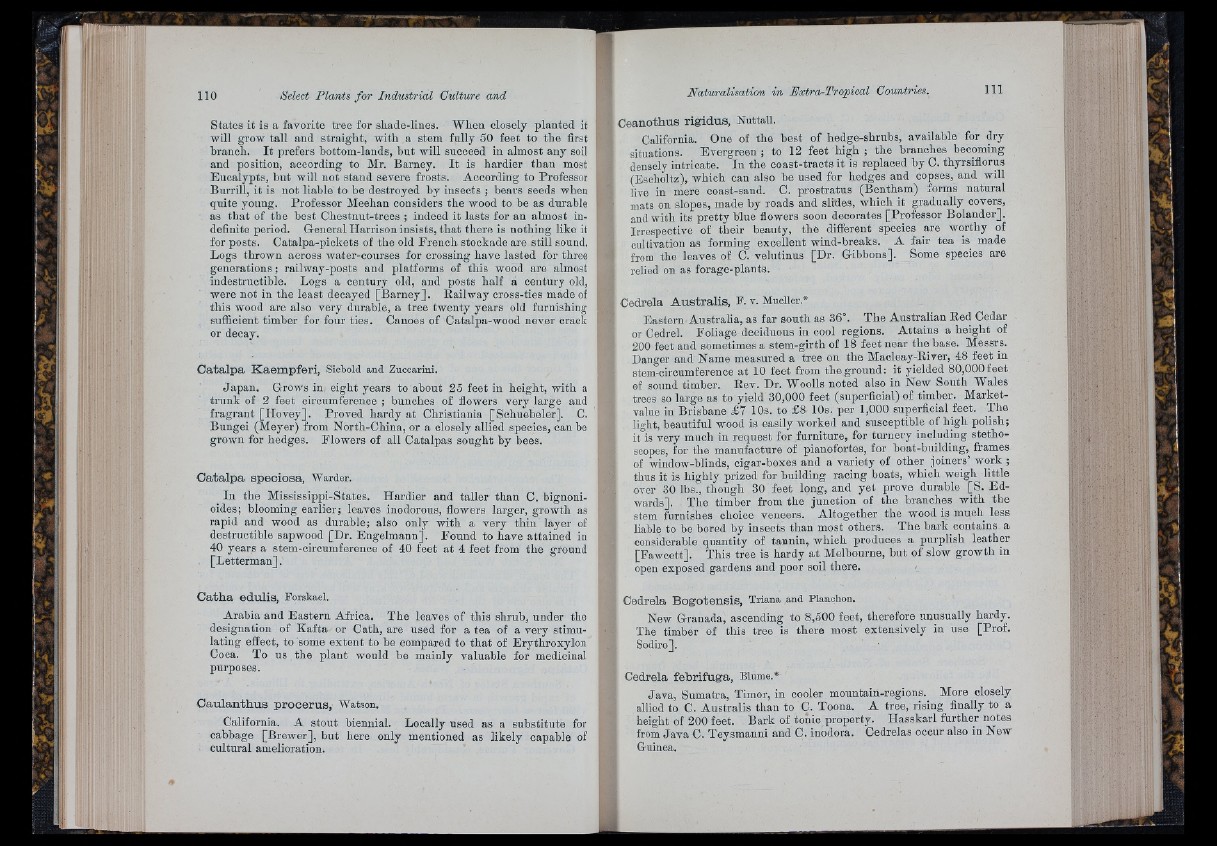
• i'f.
'■ fr ':i
M -fr
States it is a favorite tree for shade-lines. When closely planted it
will grow tall aud straight, with a stem fully 50 feet to the first
hranoli. I t prefers bottom-lands, but will succeed in almost any soil
and position, aoeording to Mr. Barney. I t is hardier than most
Eucalypts, but will not stand severe frosts. According to Professor
Burrill, it is not liable to be destroyed by insects ; bears seeds when
quite young. Professor Meehan considers the wood to be as durable
as th a t of the best Chestnut-trees ; indeed it lasts for an almost indefinite
period. General Harrison insists, th a t there is nothing like it
for posts. Catalpa-pickets of the old French stockade are still sound.
Logs thrown across water-courses for crossing have lasted for three
generations; railway-posts and platforms of this wood are almost
mdestructible. Logs a century old, and posts half a century old,
were not in the least decayed [Barney]. Railway cross-ties made of
this wood are also very durable, a tree twenty years old furnishing
suiflcient timber for four ties. Canoes of Catalpa-wood never crack
or decay.
C a ta lp a K a em p fe r i, Siebold and Zuccarini.
Japan. Grows in eight years to about 25 feet in height, with a
trunk of 2 feet circumference ; bunches of flowers very large and
fragrant [Hovey]. Proved hardy at Christiania [Schuebeler]. C.
Bungei (Meyer) from North-China, or a closely allied species, can be
grown for hedges. Flowers of all Catalpas sought by bees.
C a ta lp a sp e c io sa , Warder.
In the Mississippi-States. Hardier and taller than C. bignonioides;
blooming earlier; leaves inodorous, flowers larger, growth as
rapid and wood as durable; also only with a very thin layer of
destructible sapwood [Dr. Engelmann]. Found to have attained in
40 years a stem-circumference of 40 feet a t 4 feet from the ground
[Letterman].
C a th a e d u lis, Forskael.
Arabia and Eastern Africa. The leaves of this shrub, under the
designation of Kafta or Gath, are used for a tea of a very stimulating
eifect, to some extent to be compared to th a t of Erythroxylon
Coca. To us the plant would be mainly valuable for medicinal
purposes.
C a u la n th u s p ro c e ru s , Watson.
California. A stout biennial. Locally used as a substitute for
cabbage [Brewer], but here only mentioned as likely capable of
cultural amelioration.
C e a n o th u s r ig id u s , Nuttall.
California. One of the best of hedge-shrubs, available for dry
situations. Evergreen ; to 12 feet high ; the branches becoming
densely intricate. In the coast-tracts it is replaced by C. thyrsiflorus
(Escholtz), which can also be used for hedges and copses, and will
live in mere coast-sand. C. prostratus (Bentham) forms natural
mats on slopes, made by roads and slides, which it gradually covers,
and with its pretty blue flowers soon decorates [Professor Bolander].
Irrespective of their beauty, the different species are worthy of
cultivation as forming excellent wind-breaks. A fair tea is^ made
from the leaves of C. velutinus [Dr. Gibbons]. Some species are
relied on as forage-plants.
Cedrela A u s tr a lis , F. v. Mueller.*
Eastern Australia, as far south as 36“. The Australian Red Cedar
or Cedrel. Foliage deciduous in cool regions. Attains a height of
200 feet and sometimes a stem-girth of 18 feet near the base. Messrs.
Danger and Name measured a tree on the Macleay-River, 48 feet in
stem-circumference a t 10 feet from the ground: it yielded 80,000 feet
of sound timber. Rev. Dr. Woolls noted also in New South Wales
trees so large as to yield 30,000 feet (superficial) of timber. Market-
value in Brisbane £ 7 10s. to £8 10s. per 1,000 superficial feet. The
light, beautiful wood is easily worked and susceptible of high polish;
iAs very much in request for furniture, for turnery including stethoscopes,
for the manufacture of pianofortes, for boat-building, frames
of window-blinds, cigar-boxes and a variety of other joiners’ work ;
thus it is highly prized for building racing boats, which weigh little
over 30 lbs., though 30 feet long, and yet prove durable [S. Edwards].
The timber from the junction of the branches with the
stem furnishes choice veneers. Altogether the wood is much less
liable to be bored by insects than most others. The bark contains a
considerable quantity of tannin, which produces a purplish leather
[Fawcett]. This tree is hardy a t Melbourne, but of slow growth in
open exposed gardens and poor soil there.
Cedrela B o g o ten sis, Triana and Planchón.
New Granada, ascending to 8,500 feet, therefore unusually hardy.
The timber of this tree is there most extensively in use [Prof.
Sodiro].
Cedrela fe b r ífu g a , Blume.*
Java, Sumatra, Timor, in cooler mountain-regions.^ More closely
allied to C. Australis than to C. Toona. A tree, rising finally to a
height of 200 feet. Bark of tonic property. Hasskarl further notes
from Jav a C. Teysmanni and C. inodora. Cedrelas occur also in New
Guinea.
fr' ii